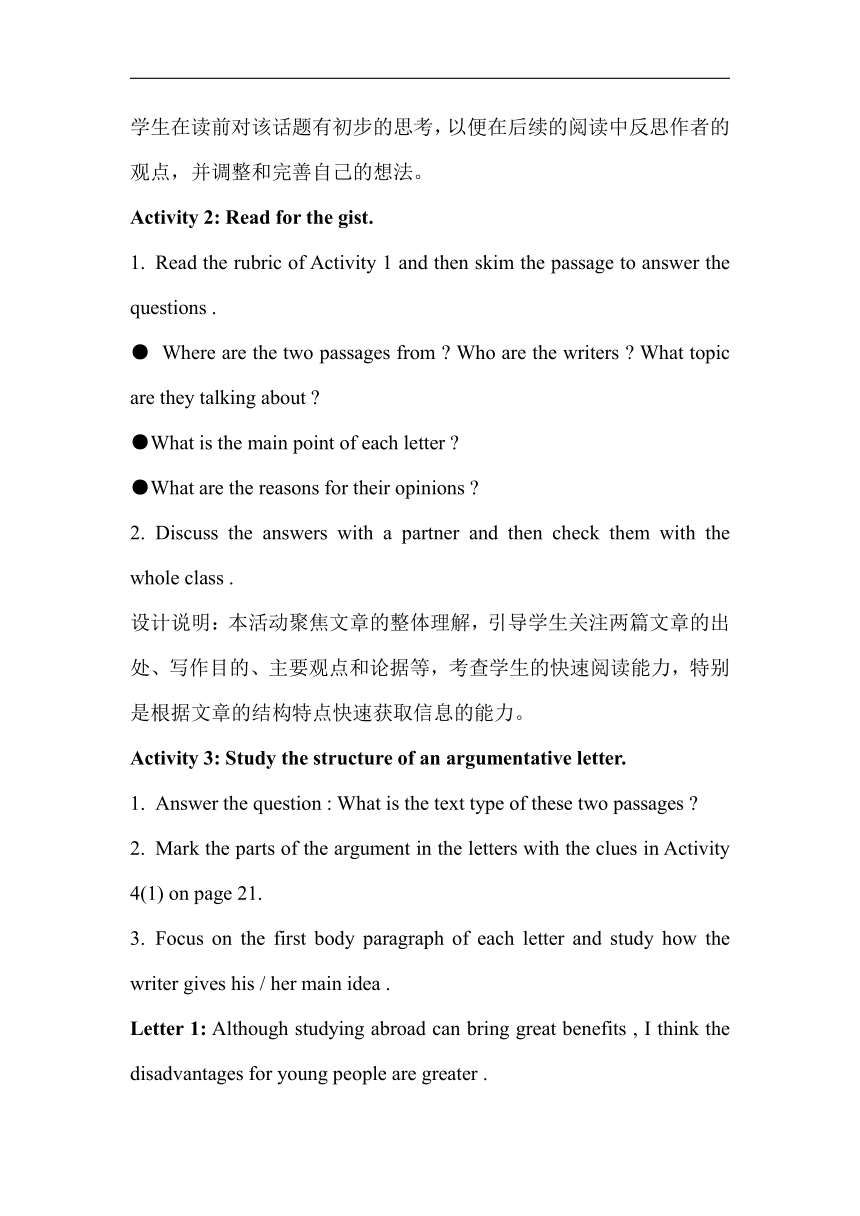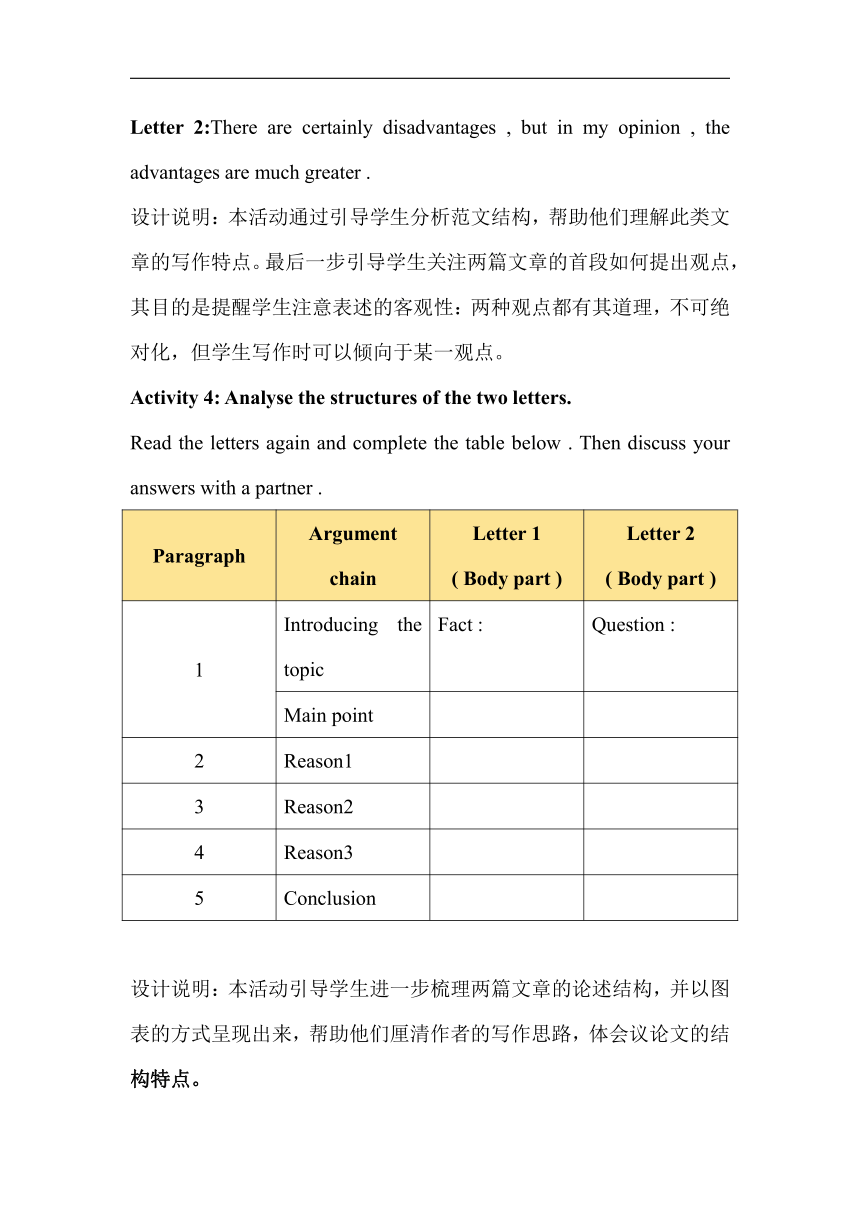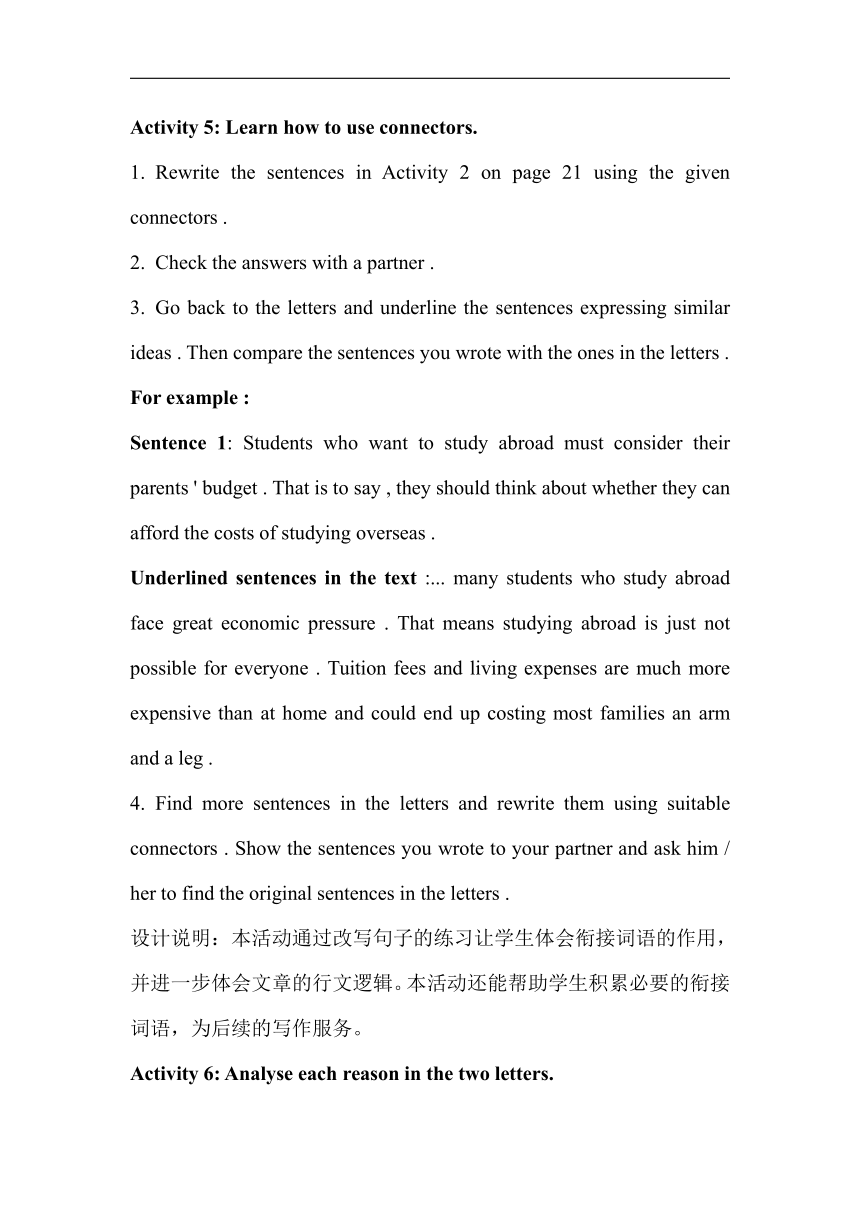人教版(2019)选择性必修第二册Unit 2 Bridging Cultures Reading for Writing 教学设计
文档属性
| 名称 | 人教版(2019)选择性必修第二册Unit 2 Bridging Cultures Reading for Writing 教学设计 |  | |
| 格式 | docx | ||
| 文件大小 | 72.2KB | ||
| 资源类型 | 教案 | ||
| 版本资源 | 人教版(2019) | ||
| 科目 | 英语 | ||
| 更新时间 | 2024-04-14 17:14:04 | ||
图片预览





文档简介
UNIT 2 BRIDGING CULTURES 单元整体教学设计
人教版必修二Unit 2 Bridging Cultures 第五至六课时
Reading and Writing教学设计
I.教学内容
Student Book : Using Language ( Expressing your opinions on studying abroad )
II.课时目标
第五课时
学生通过本课时的学习,能够:
读懂两篇谈论出国留学利弊的文章,准确把握作者的写作目的、基本论点和论证思路。
通过分析阅读文章总结议论文的文体特征,梳理议论文的基本写作结构。
在阅读中体会衔接词语的作用,并学会使用衔接词语改写句子,使句子逻辑更清晰。
第六课时
学生通过本课时的学习,能够:
正确认识出国留学的利与弊,客观、全面、深入地分析问题,并形成自己的观点。
进一步理解衔接词语的作用,并按照其语义功能积累一些常见的衔接词语。
就出国留学的利或弊写一篇观点明确、论证严谨的议论文。
参考同伴的评价和建议修改作文。
III.教学思路
第五课时侧重阅读理解和语言结构与分析,主要引领学生理解两篇阅读文章的内容,包括语篇的来源、写作目的、作者的中心论点以及支持中心论点的分论点,并梳理文章的结构,把握议论文的写作特点。本课时还通过改写句子练习引导学生关注衔接词语的使用,理解作者的论证思路,并学会清晰、严谨地表达观点。最后围绕文章论题的讨论能够激活学生的思维,帮助他们形成自己的观点,并梳理相关论据,为后面的写作作准备。
第六课时侧重写作过程的引导,从一场辩论开始,让学生利用课前收集的信息,在辩论中进一步确定和完善自己的观点和论据。接下来,教师引导学生参照范文的结构写出提纲和要点,并进一步梳理各类衔接词语。在此基础上,教师引导学生完成初稿,开展同伴互评。课下让学生完成定稿并在班上展示分享。
IV.教学过程
第五课时
Activity 1: Express your opinions on studying abroad .
Read the title of this section " Express your opinions on studying abroad ". Discuss the questions.
● Why do you think people choose to study abroad
●Do you think it ' s necessary to study abroad Why or why not
设计说明:本活动启发学生围绕出国留学的话题展开讨论,目的是让学生在读前对该话题有初步的思考,以便在后续的阅读中反思作者的观点,并调整和完善自己的想法。
Activity 2: Read for the gist.
Read the rubric of Activity 1 and then skim the passage to answer the questions .
● Where are the two passages from Who are the writers What topic are they talking about
●What is the main point of each letter
●What are the reasons for their opinions
Discuss the answers with a partner and then check them with the whole class .
设计说明:本活动聚焦文章的整体理解,引导学生关注两篇文章的出处、写作目的、主要观点和论据等,考查学生的快速阅读能力,特别是根据文章的结构特点快速获取信息的能力。
Activity 3: Study the structure of an argumentative letter.
Answer the question : What is the text type of these two passages
Mark the parts of the argument in the letters with the clues in Activity 4(1) on page 21.
Focus on the first body paragraph of each letter and study how the writer gives his / her main idea .
Letter 1: Although studying abroad can bring great benefits , I think the disadvantages for young people are greater .
Letter 2:There are certainly disadvantages , but in my opinion , the advantages are much greater .
设计说明:本活动通过引导学生分析范文结构,帮助他们理解此类文章的写作特点。最后一步引导学生关注两篇文章的首段如何提出观点,其目的是提醒学生注意表述的客观性:两种观点都有其道理,不可绝对化,但学生写作时可以倾向于某一观点。
Activity 4: Analyse the structures of the two letters.
Read the letters again and complete the table below . Then discuss your answers with a partner .
Paragraph Argument chain Letter 1 ( Body part ) Letter 2 ( Body part )
1 Introducing the topic Fact : Question :
Main point
2 Reason1
3 Reason2
4 Reason3
5 Conclusion
设计说明:本活动引导学生进一步梳理两篇文章的论述结构,并以图表的方式呈现出来,帮助他们厘清作者的写作思路,体会议论文的结构特点。
Activity 5: Learn how to use connectors.
Rewrite the sentences in Activity 2 on page 21 using the given connectors .
Check the answers with a partner .
Go back to the letters and underline the sentences expressing similar ideas . Then compare the sentences you wrote with the ones in the letters .
For example :
Sentence 1: Students who want to study abroad must consider their parents ' budget . That is to say , they should think about whether they can afford the costs of studying overseas .
Underlined sentences in the text :... many students who study abroad face great economic pressure . That means studying abroad is just not possible for everyone . Tuition fees and living expenses are much more expensive than at home and could end up costing most families an arm and a leg .
Find more sentences in the letters and rewrite them using suitable connectors . Show the sentences you wrote to your partner and ask him / her to find the original sentences in the letters .
设计说明:本活动通过改写句子的练习让学生体会衔接词语的作用,并进一步体会文章的行文逻辑。本活动还能帮助学生积累必要的衔接词语,为后续的写作服务。
Activity 6: Analyse each reason in the two letters.
Read the letters carefully and underline the evidence the writers use to support each reason .
Tell your partner how the writers support his / her reasons without looking at the texts . Your partner can ask questions and you are supposed to give answers .
设计说明:本活动让学生向同伴口头转述作者的论证思路,并回答同伴的提问,旨在调动学生学习的主体性,为学生创造独立阅读与内化文章内容的机会,进而深化对文章的理解。
Activity 7: Discuss the ideas in the two letters.
Work in groups and discuss Question 1 in Activity 3 on page 21. Make a list of the advantages or disadvantages of studying abroad that you can think of .
Work in pairs and discuss Question 2 in Activity 3.
3. Explain why you think the letters are well written . List some good expressions the writers use if necessary .
设计说明:本活动让学生在理解两篇文章内容的基础上进一步思考作者的观点,一方面通过补充列举出国留学更多的利和弊培养学生思维的开放性,另一方面引导学生评价两篇文章,学习文章中好的表达法,并形成自己的观点,为后续的写作作准备。
Assignment
Interview your family members , relatives , neighbours , etc ., especially those who have studied abroad and collect their opinions on studying abroad and the reasons they give . List the advantages and disadvantages .
设计说明:该作业让学生课下调查并整理不同人群对于出国留学的看法,有助于学生形成更全面、更理性的观点。该活动还可为下节课的小辩论以及后续的写作作准备。
第六课时
Activity 1: Debate on the advantages and disadvantages of studying abroad.
Choose a side : Studying abroad is a good / bad idea .
Join your group with either of these two ideas . Take turns stating your idea to support your group . Or show your disagreement to ideas from the other group .
设计说明:辩论活动可以充分激发学生的兴趣,学生需要在辩论中不断梳理并完善自己的思路和论点,从而训练思维和论证的严谨性。本活动还为后续的写作活动积累了相关表达。
Activity 2: Work out the outline.
1.Write down the outline according to the clues in Activity 4(1) on page 21.
Question or fact / Main idea
Reason 1/Evidence
Reason 2/Evidence
Reason 3/Evidence
Conclusion
2.Go over the information you collected before class and the ideas you got from the previous debate . Take notes in the outline above using just key words .
设计说明:本活动引导学生梳理文章的写作框架,并在课下调查和课上辩论的基础上记录并整理信息,为后续的写作作结构、信息和语言方面的准备。
Activity 3: Analyse the use of connectors in the argumentative letters.
Read through the two letters on page 20 and underline all the connectors .
Read the sentences without the connectors . Discuss the function of connectors with a partner .
Read the tip " Use connectors " on page 21 and discuss with a partner why connectors are important in an argumentative essay .
Study the connectors in Activity 4(2) on page 21 and add more examples to the list .
Some common connectors include :
●增补( Addition ): in addition , furthermore , again , also , besides , moreover , what ' s more , similarly , next , finally
●比较( Comparison ): in the same way , similarly , equally , in comparison , just as 对照( Contrast ): in contrast , on the other hand , instead , however , nevertheless , unlike , even though ,
●因果( Cause and effect ): because , because of , for , since , due to , owing to , thanks to , as a result ( of ), accordingly , hence , so , thus 强调( Emphasis ): certainly , above all , indeed , of course , surely , actually , as a matter of fact , chiefly , especially , primarily , in particular , undoubtedly , absolutely , most importantly
●让步( Concession ): although , though , after all , in spite of , nevertheless , still , provided , while it is true
●例证( Exemplification ): for example , for instance , that is , namely , such as , in other words , in this case
●总结( conclusion ): to sum up , to conclude , in a word , in short , in brief , all in all , in all , to put it in a nutshell , in summary
●推断( Inference ): therefore , as a result ( of ), consequently , accordingly , so , otherwise
●时间和空间( Time and space ): afterwards , after , first , later , then , soon ; outside , near , beyond , above , below , on the right / left , in the middle , opposite , in front of
设计说明:衔接词语可以使表述更加清晰、严谨。本部分聚焦表达观点和用于论证两类衔接词语。本活动不仅帮助学生基于语义学习和拓展此类表达,还引导他们深入体会衔接词语的作用。
Activity 4: Write the first draft .
Read the rubric for Activity 5 on page 21 and answer the questions .
● Whom are you writing to
● What is the aim of your writing
● What are you going to write
Read the checklist below and focus on the items that will be graded .
写作评价表
项目 评价( ABC 三级) 修改建议
文章结构 观点是否明确
主体段落结构是否符合逻辑并具有说服力
结论是否明确
语言特点 衔接词语使用情况
语言的规范性 单词、语法错误情况
卷面书写
Write down your first draft with the help of the outline and the notes you finished earlier . Finish the writing in 25 minutes .
设计说明:写作前阅读评价表,有助于学生明确写作标准并为之努力,也能帮助学生在同伴互评过程中提出全面且有针对性的修改建议。要求学生现场完成议论文初稿有助于锻炼学生限时写作的能力,这也是高中生必备的应试技能之一。
Activity 5: Peer evaluation.
Exchange your draft with a partner and use the checklist to give feedback on your partner ' s draft .
Share your comments on your partner ' s draft with the whole class . Get more ideas from your classmates and the teacher .
设计说明:本活动要求学生交换草稿参考上面的评价表给出反馈,然后与全班分享自己的评语和建议,这样做是为了增进学生之间的交流,提升学生互评作品的能力。
Assignment
Revise your passage with the help of your partner ' s comments . Then put up your passage on the classroom wall and share your work with your classmates .
设计说明:该作业让学生课下参考同伴的建议修改初稿,定稿后将其张贴在班级墙壁上,与同学分享。这样既给学生提供自我展示的机会,又能促进学生相互学习。
人教版必修二Unit 2 Bridging Cultures 第五至六课时
Reading and Writing教学设计
I.教学内容
Student Book : Using Language ( Expressing your opinions on studying abroad )
II.课时目标
第五课时
学生通过本课时的学习,能够:
读懂两篇谈论出国留学利弊的文章,准确把握作者的写作目的、基本论点和论证思路。
通过分析阅读文章总结议论文的文体特征,梳理议论文的基本写作结构。
在阅读中体会衔接词语的作用,并学会使用衔接词语改写句子,使句子逻辑更清晰。
第六课时
学生通过本课时的学习,能够:
正确认识出国留学的利与弊,客观、全面、深入地分析问题,并形成自己的观点。
进一步理解衔接词语的作用,并按照其语义功能积累一些常见的衔接词语。
就出国留学的利或弊写一篇观点明确、论证严谨的议论文。
参考同伴的评价和建议修改作文。
III.教学思路
第五课时侧重阅读理解和语言结构与分析,主要引领学生理解两篇阅读文章的内容,包括语篇的来源、写作目的、作者的中心论点以及支持中心论点的分论点,并梳理文章的结构,把握议论文的写作特点。本课时还通过改写句子练习引导学生关注衔接词语的使用,理解作者的论证思路,并学会清晰、严谨地表达观点。最后围绕文章论题的讨论能够激活学生的思维,帮助他们形成自己的观点,并梳理相关论据,为后面的写作作准备。
第六课时侧重写作过程的引导,从一场辩论开始,让学生利用课前收集的信息,在辩论中进一步确定和完善自己的观点和论据。接下来,教师引导学生参照范文的结构写出提纲和要点,并进一步梳理各类衔接词语。在此基础上,教师引导学生完成初稿,开展同伴互评。课下让学生完成定稿并在班上展示分享。
IV.教学过程
第五课时
Activity 1: Express your opinions on studying abroad .
Read the title of this section " Express your opinions on studying abroad ". Discuss the questions.
● Why do you think people choose to study abroad
●Do you think it ' s necessary to study abroad Why or why not
设计说明:本活动启发学生围绕出国留学的话题展开讨论,目的是让学生在读前对该话题有初步的思考,以便在后续的阅读中反思作者的观点,并调整和完善自己的想法。
Activity 2: Read for the gist.
Read the rubric of Activity 1 and then skim the passage to answer the questions .
● Where are the two passages from Who are the writers What topic are they talking about
●What is the main point of each letter
●What are the reasons for their opinions
Discuss the answers with a partner and then check them with the whole class .
设计说明:本活动聚焦文章的整体理解,引导学生关注两篇文章的出处、写作目的、主要观点和论据等,考查学生的快速阅读能力,特别是根据文章的结构特点快速获取信息的能力。
Activity 3: Study the structure of an argumentative letter.
Answer the question : What is the text type of these two passages
Mark the parts of the argument in the letters with the clues in Activity 4(1) on page 21.
Focus on the first body paragraph of each letter and study how the writer gives his / her main idea .
Letter 1: Although studying abroad can bring great benefits , I think the disadvantages for young people are greater .
Letter 2:There are certainly disadvantages , but in my opinion , the advantages are much greater .
设计说明:本活动通过引导学生分析范文结构,帮助他们理解此类文章的写作特点。最后一步引导学生关注两篇文章的首段如何提出观点,其目的是提醒学生注意表述的客观性:两种观点都有其道理,不可绝对化,但学生写作时可以倾向于某一观点。
Activity 4: Analyse the structures of the two letters.
Read the letters again and complete the table below . Then discuss your answers with a partner .
Paragraph Argument chain Letter 1 ( Body part ) Letter 2 ( Body part )
1 Introducing the topic Fact : Question :
Main point
2 Reason1
3 Reason2
4 Reason3
5 Conclusion
设计说明:本活动引导学生进一步梳理两篇文章的论述结构,并以图表的方式呈现出来,帮助他们厘清作者的写作思路,体会议论文的结构特点。
Activity 5: Learn how to use connectors.
Rewrite the sentences in Activity 2 on page 21 using the given connectors .
Check the answers with a partner .
Go back to the letters and underline the sentences expressing similar ideas . Then compare the sentences you wrote with the ones in the letters .
For example :
Sentence 1: Students who want to study abroad must consider their parents ' budget . That is to say , they should think about whether they can afford the costs of studying overseas .
Underlined sentences in the text :... many students who study abroad face great economic pressure . That means studying abroad is just not possible for everyone . Tuition fees and living expenses are much more expensive than at home and could end up costing most families an arm and a leg .
Find more sentences in the letters and rewrite them using suitable connectors . Show the sentences you wrote to your partner and ask him / her to find the original sentences in the letters .
设计说明:本活动通过改写句子的练习让学生体会衔接词语的作用,并进一步体会文章的行文逻辑。本活动还能帮助学生积累必要的衔接词语,为后续的写作服务。
Activity 6: Analyse each reason in the two letters.
Read the letters carefully and underline the evidence the writers use to support each reason .
Tell your partner how the writers support his / her reasons without looking at the texts . Your partner can ask questions and you are supposed to give answers .
设计说明:本活动让学生向同伴口头转述作者的论证思路,并回答同伴的提问,旨在调动学生学习的主体性,为学生创造独立阅读与内化文章内容的机会,进而深化对文章的理解。
Activity 7: Discuss the ideas in the two letters.
Work in groups and discuss Question 1 in Activity 3 on page 21. Make a list of the advantages or disadvantages of studying abroad that you can think of .
Work in pairs and discuss Question 2 in Activity 3.
3. Explain why you think the letters are well written . List some good expressions the writers use if necessary .
设计说明:本活动让学生在理解两篇文章内容的基础上进一步思考作者的观点,一方面通过补充列举出国留学更多的利和弊培养学生思维的开放性,另一方面引导学生评价两篇文章,学习文章中好的表达法,并形成自己的观点,为后续的写作作准备。
Assignment
Interview your family members , relatives , neighbours , etc ., especially those who have studied abroad and collect their opinions on studying abroad and the reasons they give . List the advantages and disadvantages .
设计说明:该作业让学生课下调查并整理不同人群对于出国留学的看法,有助于学生形成更全面、更理性的观点。该活动还可为下节课的小辩论以及后续的写作作准备。
第六课时
Activity 1: Debate on the advantages and disadvantages of studying abroad.
Choose a side : Studying abroad is a good / bad idea .
Join your group with either of these two ideas . Take turns stating your idea to support your group . Or show your disagreement to ideas from the other group .
设计说明:辩论活动可以充分激发学生的兴趣,学生需要在辩论中不断梳理并完善自己的思路和论点,从而训练思维和论证的严谨性。本活动还为后续的写作活动积累了相关表达。
Activity 2: Work out the outline.
1.Write down the outline according to the clues in Activity 4(1) on page 21.
Question or fact / Main idea
Reason 1/Evidence
Reason 2/Evidence
Reason 3/Evidence
Conclusion
2.Go over the information you collected before class and the ideas you got from the previous debate . Take notes in the outline above using just key words .
设计说明:本活动引导学生梳理文章的写作框架,并在课下调查和课上辩论的基础上记录并整理信息,为后续的写作作结构、信息和语言方面的准备。
Activity 3: Analyse the use of connectors in the argumentative letters.
Read through the two letters on page 20 and underline all the connectors .
Read the sentences without the connectors . Discuss the function of connectors with a partner .
Read the tip " Use connectors " on page 21 and discuss with a partner why connectors are important in an argumentative essay .
Study the connectors in Activity 4(2) on page 21 and add more examples to the list .
Some common connectors include :
●增补( Addition ): in addition , furthermore , again , also , besides , moreover , what ' s more , similarly , next , finally
●比较( Comparison ): in the same way , similarly , equally , in comparison , just as 对照( Contrast ): in contrast , on the other hand , instead , however , nevertheless , unlike , even though ,
●因果( Cause and effect ): because , because of , for , since , due to , owing to , thanks to , as a result ( of ), accordingly , hence , so , thus 强调( Emphasis ): certainly , above all , indeed , of course , surely , actually , as a matter of fact , chiefly , especially , primarily , in particular , undoubtedly , absolutely , most importantly
●让步( Concession ): although , though , after all , in spite of , nevertheless , still , provided , while it is true
●例证( Exemplification ): for example , for instance , that is , namely , such as , in other words , in this case
●总结( conclusion ): to sum up , to conclude , in a word , in short , in brief , all in all , in all , to put it in a nutshell , in summary
●推断( Inference ): therefore , as a result ( of ), consequently , accordingly , so , otherwise
●时间和空间( Time and space ): afterwards , after , first , later , then , soon ; outside , near , beyond , above , below , on the right / left , in the middle , opposite , in front of
设计说明:衔接词语可以使表述更加清晰、严谨。本部分聚焦表达观点和用于论证两类衔接词语。本活动不仅帮助学生基于语义学习和拓展此类表达,还引导他们深入体会衔接词语的作用。
Activity 4: Write the first draft .
Read the rubric for Activity 5 on page 21 and answer the questions .
● Whom are you writing to
● What is the aim of your writing
● What are you going to write
Read the checklist below and focus on the items that will be graded .
写作评价表
项目 评价( ABC 三级) 修改建议
文章结构 观点是否明确
主体段落结构是否符合逻辑并具有说服力
结论是否明确
语言特点 衔接词语使用情况
语言的规范性 单词、语法错误情况
卷面书写
Write down your first draft with the help of the outline and the notes you finished earlier . Finish the writing in 25 minutes .
设计说明:写作前阅读评价表,有助于学生明确写作标准并为之努力,也能帮助学生在同伴互评过程中提出全面且有针对性的修改建议。要求学生现场完成议论文初稿有助于锻炼学生限时写作的能力,这也是高中生必备的应试技能之一。
Activity 5: Peer evaluation.
Exchange your draft with a partner and use the checklist to give feedback on your partner ' s draft .
Share your comments on your partner ' s draft with the whole class . Get more ideas from your classmates and the teacher .
设计说明:本活动要求学生交换草稿参考上面的评价表给出反馈,然后与全班分享自己的评语和建议,这样做是为了增进学生之间的交流,提升学生互评作品的能力。
Assignment
Revise your passage with the help of your partner ' s comments . Then put up your passage on the classroom wall and share your work with your classmates .
设计说明:该作业让学生课下参考同伴的建议修改初稿,定稿后将其张贴在班级墙壁上,与同学分享。这样既给学生提供自我展示的机会,又能促进学生相互学习。
